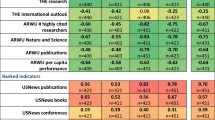Abstract
This article evaluates the scientific research competitiveness of world universities in computer science. The data source is the Essential Science Indicator (ESI) database with a time span of more than 10 years, from 01/01/1996 to 08/31/2006. We establish a hierarchical indicator system including four primary indicators which consist of scientific research production, influence, innovation and development and six secondary indicators which consist of the number of papers, total citations, highly cited papers, hot papers, average citations per paper and the ration of highly cited papers to papers. Then we assign them with proper weights. Based on these, we obtain the rankings of university and country/territory competitiveness in computer science. We hope this paper can contribute to the further study in the evaluation of a certain subject or a whole university.
Similar content being viewed by others
References
Calvino, A. M. (2006), Assessment of research performance in food science and technology: Publication behavior of five Iberian-American countries (1992–2003). Scientometrics, 69(1): 103–116.
Garcia, C. E., Sanz-Menendez, L. (2005). Competition for funding as an indicator of research competitiveness. Scientometrics, 64(3): 271–300.
Huang, M. H., Chang, H. W., Chen, D. Z. (2006), Research evaluation of research-oriented universities in Taiwan from 1993 to 2003. Scientometrics, 67(3): 419–435.
National Science Council (2003), Evaluation of research achievement for universities and college in Taiwan. Taipei, Taiwan: National Science Council.
Nederhof, A. J. (2005), Bibliometric monitoring of research performance in the social sciences and the humanities: A review. Scientometrics, 66(1): 81–100.
Nederhof, A. J., Van Raan, A. F. J. (2003), A validation study of bibliometric indicators: the comparative performance of cum laude doctorates in chemistry. Scientometrics, 57(2): 257–280.
Nederhof, A. J., Meijer, R. F., Moed, H. F., Van Raan, A. F. J. (1993), Research performance indicators for university departments: A study of an agricultural university. Scientometrics, 27(2): 157–178.
Pomfret, R., Wang, L. C. (2003), Evaluating the research output of Australian universities’ economics departments. Australian Economic Papers, 42(4): 249–256.
Rinia, E. J., Van Leeuwen, T. N., Van Raan, A. F. J. (2002), Impact measures of interdisciplinary research in physics. Scientometrics, 53(2): 241–248.
Science Watch (2005), Canadian Universities: U. Toronto Still Tops. Science Watch, 16(5): 1–2.
Shanghai Jiao Tong University (2006), Academic ranking of world universities 2006. Retrieved May 25, 2007, from http://ed.sjtu.edu.cn/rank.
The Times Higher Education Supplement (2006), World University Rankings 2006. Retrieved May 25, 2007, from http://www.thes.co.uk/worldrankings.
Thomson Scientific (2007), ESI v2.0 Reference Card. Retrieved April 20, 2007, from http://scientific.thomson.com/media/sepdf/esi-0805-q.pdf.
Van Leeuwen, T. N. (2005), The application of bibliometric analysis in the evaluation of social science research. Who benefits from it, and why it is still feasible. Scientometrics, 66(1): 133–154.
Van Leeuwen, T. N., Visser, M. S., Moed, H. F., Nederhof, T. J., Van Raan, A. F. J. (2003), Holy Grail of science policy: Exploring and combining bibliometric tools in search of scientific excellence. Scientometrics, 57(2): 257–280.
Van Raan, A. F. J. (1999), Advanced bibliometric methods for the evaluation of universities. Scientometrics, 45(3): 417–423.
Van Raan, A. F. J. (2005), Fatal attraction: Conceptual and methodological problems in the ranking of universities by bibliometric methods. Scientometrics, 62(1): 133–143.
Van Raan, A. F. J. (2006), Comparison of the Hirsch-index with standard bibliometric indicators and with peer judgment for 147 chemistry research groups. Scientometrics, 67(3): 491–502.
Wallin, J. A. (2005), Bibliometric methods: Pitfalls and possibilities. Basic & Clinical Pharmacology & Toxicology, 97(5): 261–275.
Author information
Authors and Affiliations
Corresponding author
Rights and permissions
About this article
Cite this article
Ma, R., Ni, C. & Qiu, J. Scientific research competitiveness of world universities in computer science. Scientometrics 76, 245–260 (2008). https://doi.org/10.1007/s11192-007-1913-7
Received:
Published:
Issue Date:
DOI: https://doi.org/10.1007/s11192-007-1913-7




